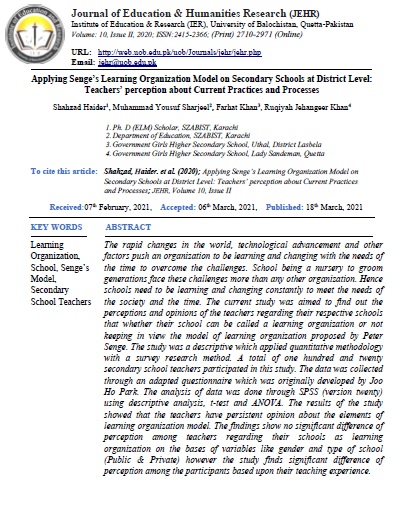Applying Senge’s Learning Organization Model on Secondary Schools
Teachers’ Perception about Current Practices and Processes
Keywords:
Learning Organization, Secondary Schools, Teachers, Senge's Model, Learning Organization, School, Senge’s Model, Secondary School TeachersAbstract
The rapid changes in the world, technological advancement and other factors push an organization to be learning and changing with the needs of the time to overcome the challenges. School being a nursery to groom generations face these challenges more than any other organization. Hence schools need to be learning and changing constantly to meet the needs of the society and the time. The current study was aimed to find out the perceptions and opinions of the teachers regarding their respective schools whether their school can be called a learning organization or not keeping in view the model of learning organization proposed by Peter Senge. The study was descriptive in nature which applied quantitative methodology with a survey research method. A total of n=120 secondary school teachers participated in this study. The data was collected through an adapted questionnaire which was originally developed by Joo Ho Park. The analysis of data was done through SPSS V22 using descriptive analysis, t-test and ANOVA. The results of the study showed that the teachers have persistent opinion about the elements of learning organization model. The findings show no significant difference of perception among teachers regarding their schools as learning organization on the basis of variables like gender and type of school (Public & Private). However, the study finds significant difference of perception among the participants based upon their teaching experience.
References
Celep, C., Konaklı, T., & Recepoğlu, E. (2011). Organizational learning: Perceptions of teachers in Turkey. International Online Journal of Educational Sciences, 3(2), 474-493.
Davis, D. C., & Lopuch, V. S. (2016). Learning organizations: Connections between diversity and innovation. In J. Prescott, Handbook of Research on Race, Gender, and the Fight for Equality (pp. 267–297). Hershey, PA: IGI Global.
Dawoood, S., Mammona, D., Fahmeeda, D., & Ahmed, A. (2015). Learning Organization–Conceptual and Theoretical Overview. International Journal of Humanities Social Sciences and Education, 2(4), 93-98.
Durmont, H., Istance, D., & Benavides, F. (2010). The Nature of Learning: Using Research to Inspire Practice. Paris: Educational Research and Innovation, OECD Publishing.
Fullan, M. (2015). The New Meaning of Educational Change (5th ed.). London: Routledge.
Giles, C., & Hargreaves, A. (2006). The Sustainability of Innovative Schools as Learning Organizations and Professional Learning Communities During Standardized Reform. Educational Administration Quarterly, 42(1), 124-156.
Hansen, J. O., Jensen, A., & Nguyen, N. (2020). The responsible learning organization; Can Senge (1990) teach organizations how to become responsible innovators? The Learning Organization, 27(1), 65-74.
Jokic, S., Cosic, I., Sajfert, Z., Pecujlija, M., & Pardanjac, M. (2012). Schools as learning organizations: Empirical study in Serbia. Metalurgia I nternational, 17(2), 83-89.
Kools , M., & Stoll, L. (2016). What Makes a School a Learning Organisation? Paris: OECD Publishing,.
Kuipers, B., Higgs, M., Kickert, W., Tummers, L., Grandia, J., & Voet, J. v. (2010). The Management of Change in Public Organisations: A Literature Review. Public Administration, 20(1), 1-20.
Lahn, L. (2016). Organizational teaching and learning – a (re)view from educational science. 23(5):. The Learning Organization, 23(5), 342–356.
Marquardt, M. (2002). Building the learning organization: mastering the five elements for corporate learning. California: Consulting Psychologists.
Moloi, K. C., Grobler, B. R., & Gravett, S. J. (2002). Educators’ perceptions of the school as a learning organization in the Vanderbijlpark-North District, South Africa. South African Journal of Education, 22(2), 88–94.
Ng, P. T. (2003). The Singapore school and the School Excellence Model. Educational Research for Policy and Practice, 2(1), 27-39.
Park , J. H. (2008). Validation of Senge’s Learning Organization Model with Teachers of Vocational High Schools at the Seoul Megalopolis. Asia Pacific Education Review, 9(3), 270-284.
Recepoğlu, E. (2013). Analyzing teachers’ perceptions on learning organizations in terms of different variables. Procedia - Social and Behavioral Sciences, 93, 618-623.
Retna, K. S., & Ng, P. T. (2016). The application of learning organization to enhance learning in Singapore schools. Management in Education, 30(1), 10–18.
Schlechty, P. C. (2009). Leading for Learning: How to Transform Schools into Learning Organizations. San Francisco: Jossey-Bass.
Schleicher, A. (2015). Schools for 21st-Century Learners: Strong Leaders, Confident Teachers, Innovative approaches. Paris: OECD Publishing.
Senge, P. (1990). The Fifth Discipline. New York: Doubleday.
Senge, P. (2012). Schools that Learn. New York: Crown Business.
Senge, P. M. (2011). The Fifth Discipline: The Art & Practice of The Learning Organization. New York: Doubleday.
Stevens , J. L. (2019). The Prevalence of Peter Senge's Five Disciplines of a Learning Organization in a Rural High School's Professional Development. School of Education. St. Paul, Minnesota: Hamline University. Retrieved March 15, 2020, from https://digitalcommons.hamline.edu/hse_all/4464
Uysal, A. (2005). The perceptions of managers and teachers working in pre-school education institutions about the learning organization. Unpublished Master Thesis, Selcuk University, Koniya.
Varshney, D. (2019). Employees’ job involvement and satisfaction in a learningorganization: A study in India's manufacturing sector. Global Business and Organizational Excellence, 39(2), 51-61.




